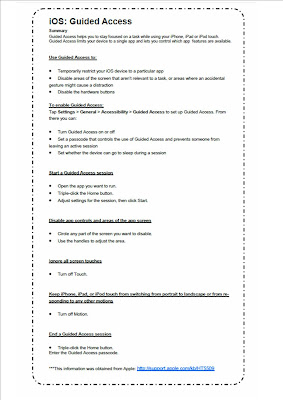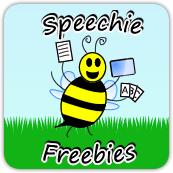What is It?
Guided Access is a settings option that allows the adult or user to restrict the ability to exit out of an app or use certain portions of an app.
Where do I find it?
Tap Settings > General > Accessibility > Guided Access to set up Guided Access. From there you can:
- Turn Guided Access on or off
- Set a passcode that controls the use of Guided Access and prevents someone from leaving an active session
- Set whether the device can go to sleep during a session
Now that Guided Access is enabled, how do I use an app with Guided Access?
Start a Guided Access session
- Open the app you want to run.
- Triple-click the Home button.
- Adjust settings for the session, then click Start.
Why do I use it?
- Facilitating focused use of a therapy app: Using Guided Access can be very effective for AAC apps. Many times, a student or child may want to quickly exit the AAC app, or if there are multiple pages to an AAC board...a student may not be ready for the multi-page level and may still need adult guidance in remaining on one designate page. As a therapist, I simply go to the app, let's say I am using Go Talk Now with a student, I triple click to activate Guided Access, and then I circle the areas of the 'page' that I do not want the student to be able to press. Again, why would I do this? If a student or child has difficulty with fine motor control or is prone to swiping across the screen, Guided Access allows me to control what the student can activate. I absolutely LOVE this feature/setting for facilitating use of AAC apps. Sometimes I also use Guided Access for other therapy-based apps, especially if a student has difficulty with fine motor. Essentially, I can 'get rid of' portions of the screen...that way the child only touches/presses areas that are needed. This helps the student feel more successful and not as frustrated! Here are some screen shots that I took to demonstrate Guided Access in use with Go Talk Now. (I apologize for my poor photos. I actually had to use my camera phone...for some reason I couldn't snap a screen shot with the iPad while Guided Access was in use. I'll have to work on that one!)

Here I just began a Guided Access session by triple clicking the home button. You triple click AFTER you are already in the app that you want.
Now, you can see that I purposefully restricted access to the bottom portion of the screen. To do this, just circle with your finger, the areas that you do not want the child to access.
In this picture, I wanted the student to begin practicing opening their personall AAC board on their own. I wanted the student to be successful and not accidentally open a different setting/page, so I 'blacked' out or disabled everything but the portion the student needed. Just hit 'start' when you are done and the app is ready to go!
To end the Guided Access session, triple click the home button...you will be prompted to enter your code. Enter the
code and you ipad will again be 'unlocked'.
- **Another important therapy feature....you can prevent your iPad from going to sleep using Guided Access! I love this!
- Home: Again, perhaps a parent may want to control what a child is doing on the iPad for a designated amount of time. At home, I sometimes will use Guided Access when I want my son or daughter to work within a specific math or reading app.
- Other Uses (also find Apple's Guided Access HELP info HERE):
- Temporarily restrict your iOS device to a particular app
- Disable areas of the screen that aren’t relevant to a task, or areas where an accidental gesture might cause a distraction
- Disable the hardware buttons
Other Tips:
Disable app controls and areas of the app screen
- Circle any part of the screen you want to disable.
- Use the handles to adjust the area.
Ignore all screen touches
- Turn off Touch.
Keep iPhone, iPad, or iPod touch from switching from portrait to landscape or from responding to any other motions
- Turn off Motion.
End a Guided Access session
- Triple-click the Home button.
- Enter the Guided Access passcode.
**I'll admit...using Guided Access takes some getting used to for therapy, especially if you want to modify a task. You will need to exit out of the app (triple click, enter your code, end guided access....now make the changes you want to the app...maybe it is to switch to a different articulation sound or change a student's AAC board...after you make the changes, you now have to re-enable guided access). So this can be time consuming at first, but once you are really familiar with Guided Access...it's a breeze! Just keep practicing. Now, I can switch in and out of Guided Access mode and make changes in just seconds. I actually leave Guided Access ON (settings) all of the time...neither my children at home nor my students have ever triple clicked and 'locked' it. So I just leave it on, then when I want to activate it, I just open the right app, triple click, and get started! I say all of this because I want people to realize just how easy it is to use!
Lastly... I made a quick 'cheat sheet' (Google Doc) for using Guided Access...feel free to use it! If in the classroom setting, keep a copy handy for all staff, you could even write the passcode on it.
Link to Google Doc:
https://docs.google.com/file/d/0B4jusdUK_Z_NRE55ZU5KeUFhQ0E/edit









.jpg?n=7331)







